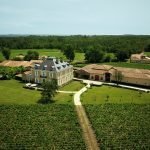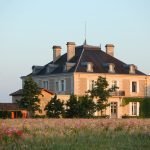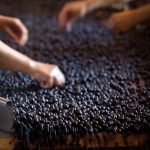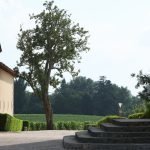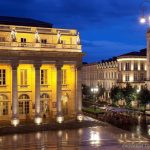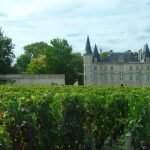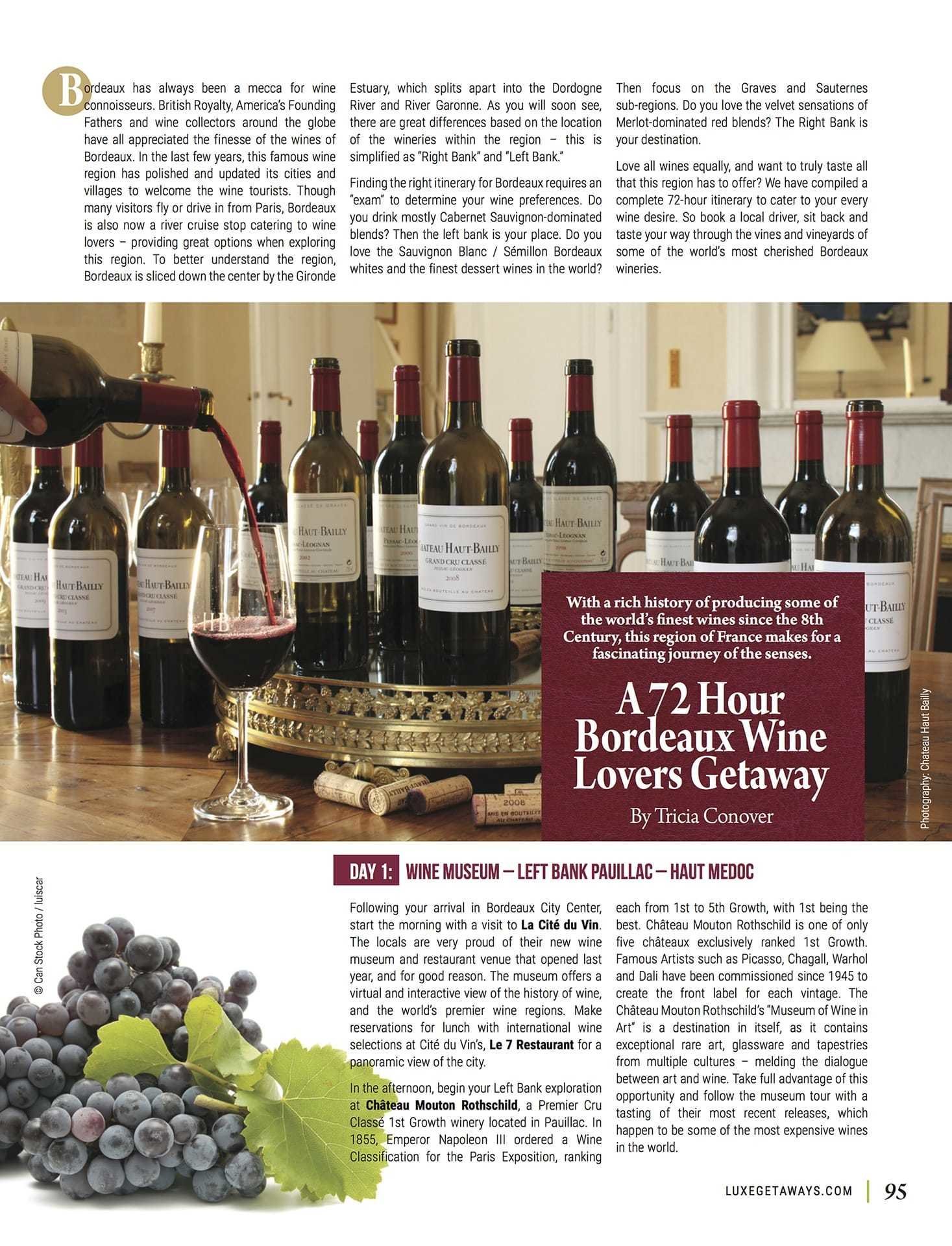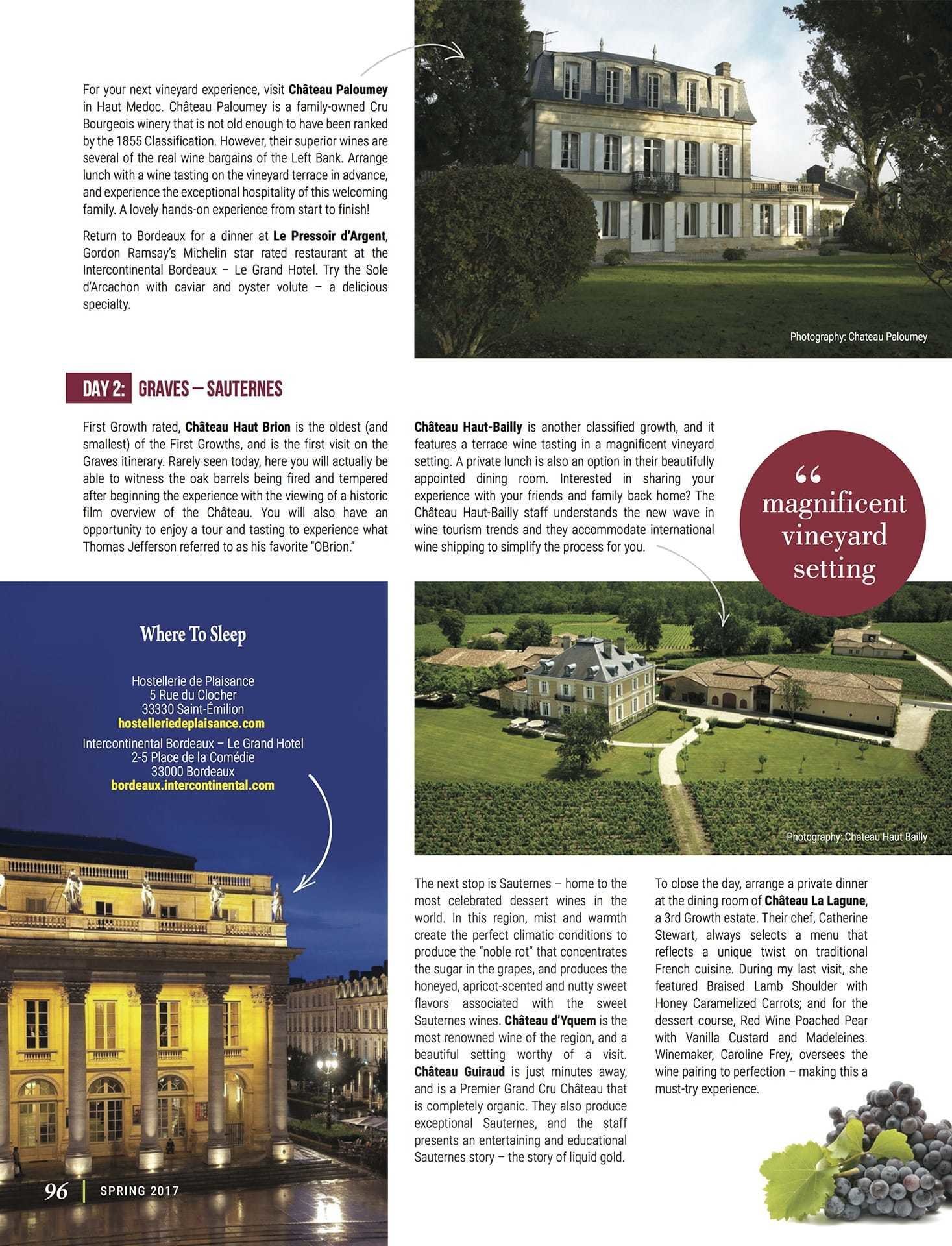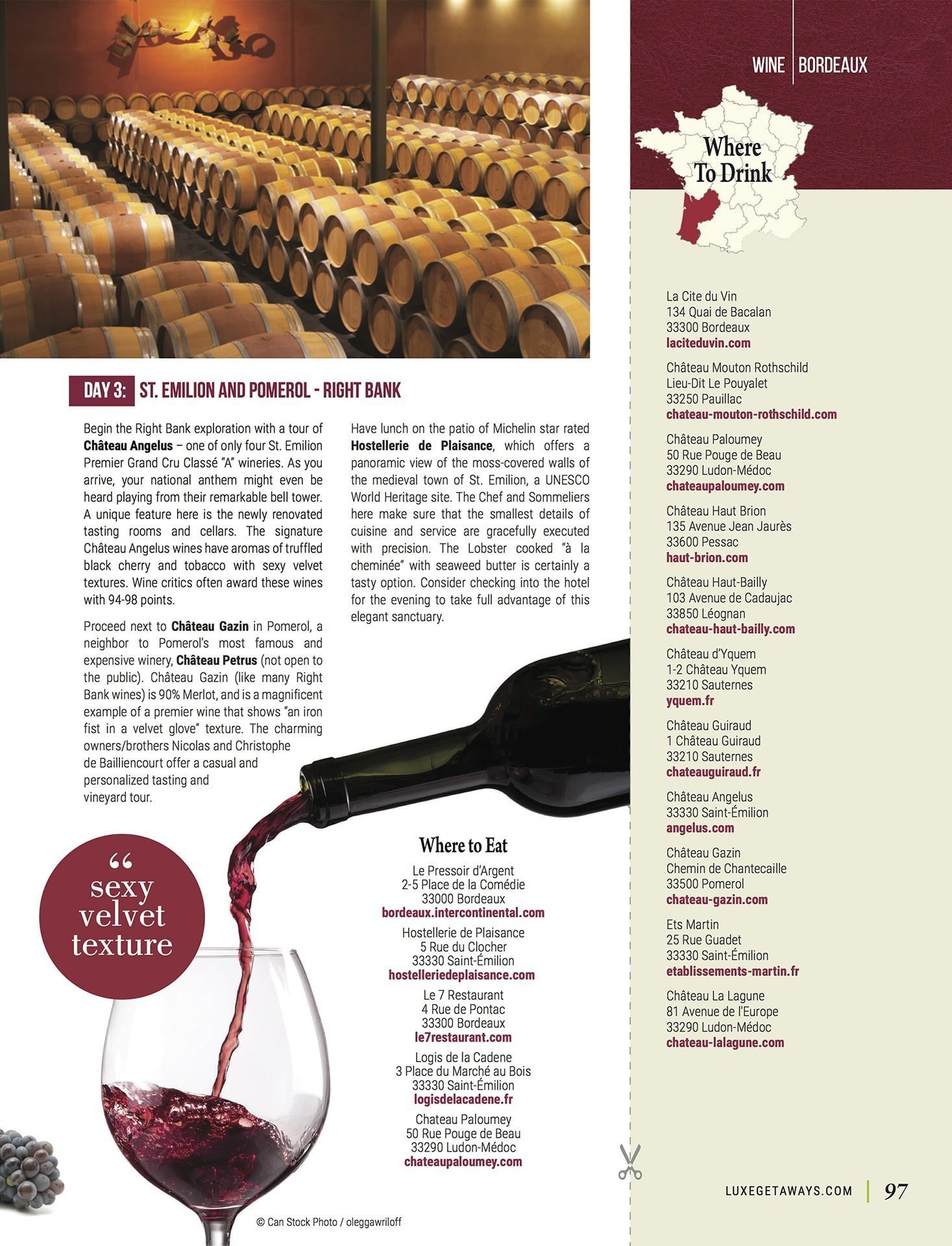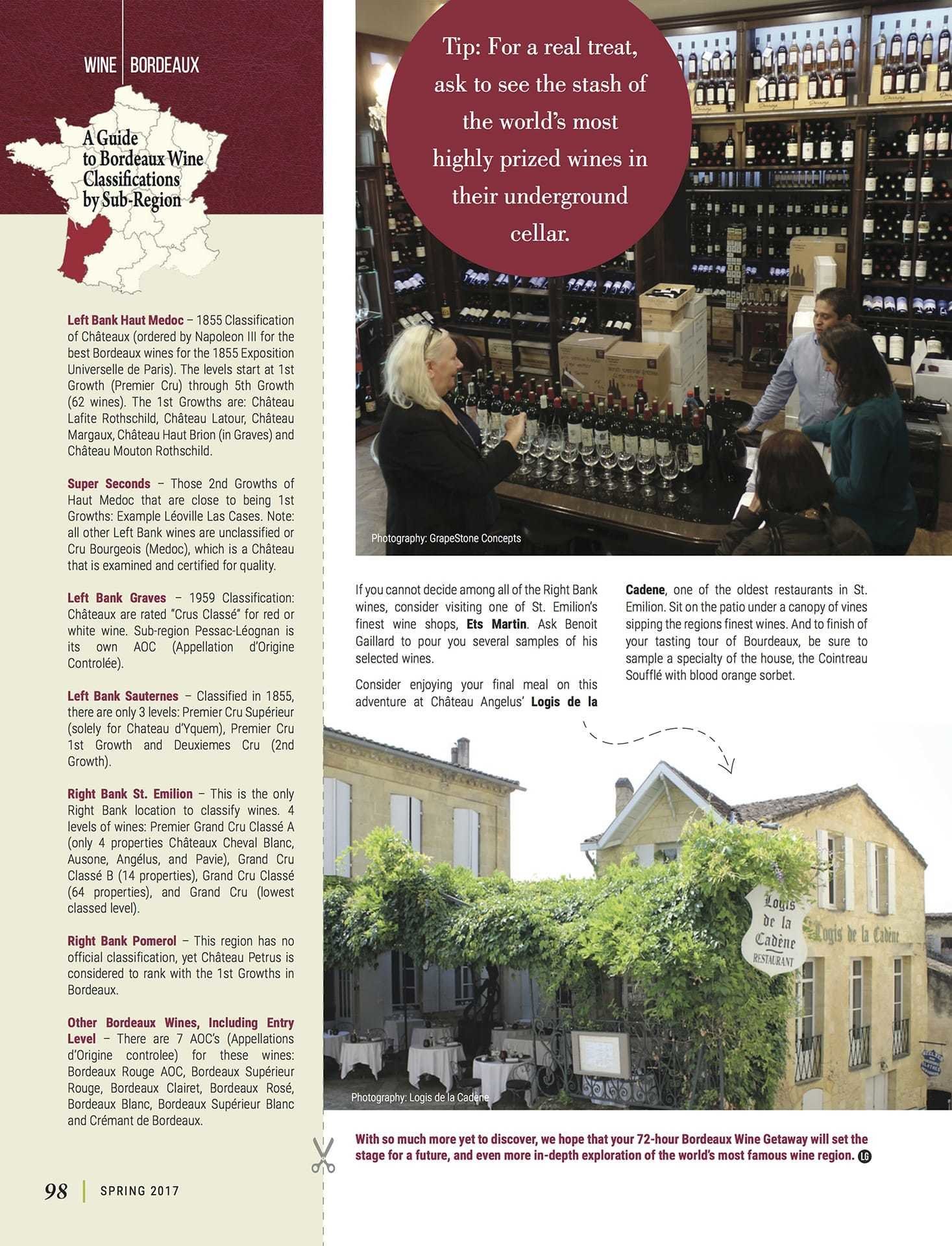LuxeGetaways Magazine – Spring 2017 | Bordeaux has always been a mecca for wine connoisseurs. British Royalty, America’s Founding Fathers and wine collectors around the globe have all appreciated the finesse of the wines of Bordeaux. In the last few years, this famous wine region has polished and updated its cities and villages to welcome the wine tourists. Though many visitors fly or drive in from Paris, Bordeaux is also now a river cruise stop catering to wine lovers – providing great options when exploring this region.
To better understand the region, Bordeaux is sliced down the center by the Gironde Estuary, which splits apart into the Dordogne River and River Garonne. As you will soon see, there are great differences based on the location of the wineries within the region – this is simplified as “Right Bank” and “Left Bank.”
Finding the right itinerary for Bordeaux requires an “exam” to determine your wine preferences. Do you drink mostly Cabernet Sauvignon-dominated blends? Then the left bank is your place. Do you love the Sauvignon Blanc / Sémillon Bordeaux whites and the finest dessert wines in the world? Then focus on the Graves and Sauternes sub-regions. Do you love the velvet sensations of Merlot-dominated red blends? The Right Bank is your destination.
Love all wines equally, and want to truly taste all that this region has to offer? We have compiled a complete 72-hour itinerary to cater to your every wine desire. So book a local driver, sit back and taste your way through the vines and vineyards of some of the world’s most cherished Bordeaux wineries.

Day 1: Wine Museum – Left Bank Pauillac – Haut Medoc
Following your arrival in Bordeaux City Center, start the morning with a visit to La Cité du Vin. The locals are very proud of their new wine museum and restaurant venue that opened last year, and for good reason. The museum offers a virtual and interactive view of the history of wine, and the world’s premier wine regions. Make reservations for lunch with international wine selections at Cité du Vin’s, Le 7 Restaurant for a panoramic view of the city.
In the afternoon, begin your Left Bank exploration at Château Mouton Rothschild, a Premier Cru Classé 1st Growth winery located in Pauillac. In 1855, Emperor Napoleon III ordered a Wine Classification for the Paris Exposition, ranking each from 1st to 5th Growth, with 1st being the best. Château Mouton Rothschild is one of only five châteaux exclusively ranked 1st Growth. Famous Artists such as Picasso, Chagall, Warhol and Dali have been commissioned since 1945 to create the front label for each vintage. The Château Mouton Rothschild’s “Museum of Wine in Art” is a destination in itself, as it contains exceptional rare art, glassware and tapestries from multiple cultures – melding the dialogue between art and wine. Take full advantage of this opportunity and follow the museum tour with a tasting of their most recent releases, which happen to be some of the most expensive wines in the world.
For your next vineyard experience, visit Château Paloumey in Haut Medoc. Château Paloumey is a family-owned Cru Bourgeois winery that is not old enough to have been ranked by the 1855 Classification. However, their superior wines are several of the real wine bargains of the Left Bank. Arrange lunch with a wine tasting on the vineyard terrace in advance, and experience the exceptional hospitality of this welcoming family. A lovely hands-on experience from start to finish!

Return to Bordeaux for a dinner at Le Pressoir d’Argent, Gordon Ramsay’s Michelin star rated restaurant at the Intercontinental Bordeaux – Le Grand Hotel. Try the Sole d’Arcachon with caviar and oyster volute – a delicious specialty.
Day 2: Graves – Sauternes
First Growth rated, Château Haut Brion is the oldest (and smallest) of the First Growths, and is the first visit on the Graves itinerary. Rarely seen today, here you will actually be able to witness the oak barrels being fired and tempered after beginning the experience with the viewing of a historic film overview of the Château. You will also have an opportunity to enjoy a tour and tasting to experience what Thomas Jefferson referred to as his favorite “OBrion.”
Château Haut-Bailly is another classified growth, and it features a terrace wine tasting in a magnificent vineyard setting. A private lunch is also an option in their beautifully appointed dining room. Interested in sharing your experience with your friends and family back home? The Château Haut-Bailly staff understands the new wave in wine tourism trends and they accommodate international wine shipping to simplify the process for you.
The next stop is Sauternes – home to the most celebrated dessert wines in the world. In this region, mist and warmth create the perfect climatic conditions to produce the “noble rot” that concentrates the sugar in the grapes, and produces the honeyed, apricot-scented and nutty sweet flavors associated with the sweet Sauternes wines. Château d’Yquem is the most renowned wine of the region, and a beautiful setting worthy of a visit. Château Guiraud is just minutes away, and is a Premier Grand Cru Château that is completely organic. They also produce exceptional Sauternes, and the staff presents an entertaining and educational Sauternes story – the story of liquid gold.
To close the day, arrange a private dinner at the dining room of Château La Lagune, a 3rd Growth estate. Their chef, Catherine Stewart, always selects a menu that reflects a unique twist on traditional French cuisine. During my last visit, she featured Braised Lamb Shoulder with Honey Caramelized Carrots; and for the dessert course, Red Wine Poached Pear with Vanilla Custard and Madeleines. Winemaker, Caroline Frey, oversees the wine pairing to perfection – making this a must-try experience.
Day 3: St. Emilion and Pomerol – Right Bank
Begin the Right Bank exploration with a tour of Château Angelus – one of only four St. Emilion Premier Grand Cru Classé “A” wineries. As you arrive, your national anthem might even be heard playing from their remarkable bell tower. A unique feature here is the newly renovated tasting rooms and cellars. The signature Château Angelus wines have aromas of truffled black cherry and tobacco with sexy velvet textures. Wine critics often award these wines with 94-98 points.
Proceed next to Château Gazin in Pomerol, a neighbor to Pomerol’s most famous and expensive winery, Château Petrus (not open to the public). Château Gazin (like many Right Bank wines) is 90% Merlot, and is a magnificent example of a premier wine that shows “an iron fist in a velvet glove” texture. The charming owner/brothers Nicolas and Christophe de Bailliencourt offer a casual and personalized tasting and vineyard tour.
Have lunch on the patio of Michelin star rated Hostellerie de Plaisance, which offers a panoramic view of the moss-covered walls of the medieval town of St. Emilion, a UNESCO World Heritage site. The Chef and Sommeliers here make sure that the smallest details of cuisine and service are gracefully executed with precision. The Lobster cooked “à la cheminée” with seaweed butter is memorable. Consider checking into the hotel for the evening to take full advantage of this elegant sanctuary.
If you cannot decide among all of the Right Bank wines, consider visiting one of St. Emilion’s finest wine shops, Ets Martin. Ask Benoit Gaillard to pour you several samples of his selected wines. Tip: For a real treat, request to see the stash of the world’s most highly prized wines in their underground cellar.

Consider enjoying your final meal on this adventure at Château Angelus’ Logis de la Cadene, one of the oldest restaurants in St. Emilion. Sit on the patio under a canopy of vines sipping the regions finest wines. And to finish of your tasting tour of Bourdeaux, be sure to sample a specialty of the house, the Cointreau Soufflé with blood orange sorbet.
With so much more yet to discover, we hope that your 72-hour Bordeaux Wine Getaway will set the stage for a future, and even more in-depth exploration of the world’s most famous wine region.
Where To Sleep
Intercontinental Bordeaux – Le Grand Hotel
2-5 Place de la Comédie
33000 Bordeaux
www.bordeaux.intercontinental.com/en
Hostellerie de Plaisance
5 Rue du Clocher
33330 Saint-Émilion
www.hostelleriedeplaisance.com
Where to Eat
Le 7 Restaurant
4 Rue de Pontac
33300 Bordeaux
www.le7restaurant.com
Le Pressoir d’Argent
2-5 Place de la Comédie
33000 Bordeaux
www.bordeaux.intercontinental.com
Hostellerie de Plaisance
5 Rue du Clocher
33330 Saint-Émilion
www.hostelleriedeplaisance.com
Logis de la Cadene
3 Place du Marché au Bois
33330 Saint-Émilion
www.logisdelacadene.fr
Chateau Paloumey
50 Rue Pouge de Beau
33290 Ludon-Médoc
www.chateaupaloumey.com
Where To Drink
La Cite du Vin
134 Quai de Bacalan
33300 Bordeaux
www.laciteduvin.com
Château Mouton Rothschild
Lieu-Dit Le Pouyalet
33250 Pauillac
www.chateau-mouton-rothschild.com
Château Paloumey
50 Rue Pouge de Beau
33290 Ludon-Médoc
www.chateaupaloumey.com
Château Haut Brion
135 Avenue Jean Jaurès
33600 Pessac
www.haut-brion.com
Château Haut-Bailly
103 Avenue de Cadaujac
33850 Léognan
www.chateau-haut-bailly.com
Château d’Yquem
1-2 Château Yquem
33210 Sauternes
www.yquem.fr/int-en/
Château Guiraud
1 Château Guiraud
33210 Sauternes
www.chateauguiraud.fr/en
Château La Lagune
81 Avenue de l’Europe
33290 Ludon-Médoc
www.chateau-lalagune.com
Château Angelus
33330 Saint-Émilion
www.angelus.com
Château Gazin
Chemin de Chantecaille
33500 Pomerol
www.chateau-gazin.com
Ets Martin
25 Rue Guadet
33330 Saint-Émilion
www.etablissements-martin.fr
A Guide to Bordeaux Wine Classifications by Sub-Region
Left Bank Haut Medoc – 1855 Classification of Châteaux (ordered by Napoleon III for the best Bordeaux wines for the 1855 Exposition Universelle de Paris). The levels start at 1st Growth (Premier Cru) through 5th Growth (62 wines). The 1st Growths are: Château Lafite Rothschild, Château Latour, Château Margaux, Château Haut Brion (in Graves) and Château Mouton Rothschild.
Super Seconds – Those 2nd Growths of Haut Medoc that are close to being 1st Growths: Example Léoville Las Cases. Note: all other Left Bank wines are unclassified or Cru Bourgeois (Medoc), which is a Château that is examined and certified for quality.
Left Bank Graves – 1959 Classification: Châteaux are rated “Crus Classé” for red or white wine. Sub-region Pessac-Léognan is its own AOC (Appellation d’Origine Controlée).
Left Bank Sauternes – Classified in 1855, there are only 3 levels: Premier Cru Supérieur (solely for Chateau d’Yquem), Premier Cru 1st Growth and Deuxiemes Cru (2nd Growth).
Right Bank St. Emilion – This is the only Right Bank location to classify wines. 4 levels of wines: Premier Grand Cru Classé A (only 4 properties Châteaux Cheval Blanc, Ausone, Angélus, and Pavie), Grand Cru Classé B (14 properties), Grand Cru Classé (64 properties), and Grand Cru (lowest classed level).
Right Bank Pomerol – This region has no official classification, yet Château Petrus is considered to rank with the 1st Growths in Bordeaux.
Other Bordeaux Wines, Including Entry Level – There are 7 AOC’s (Appellations d’Origine controlee) for these wines: Bordeaux Rouge AOC, Bordeaux Supérieur Rouge, Bordeaux Clairet, Bordeaux Rosé, Bordeaux Blanc, Bordeaux Supérieur Blanc and Crémant de Bordeaux.

